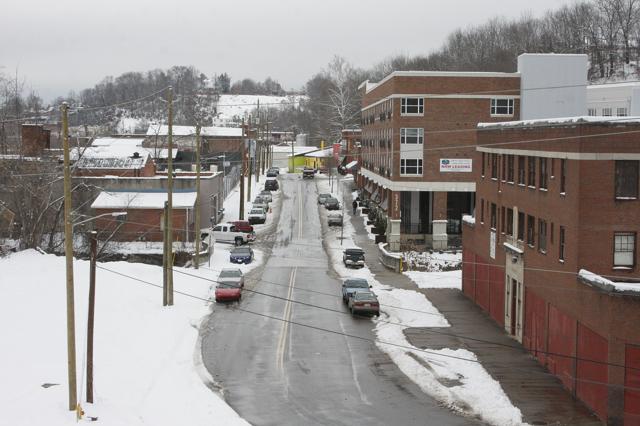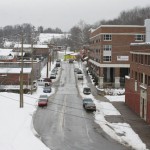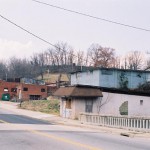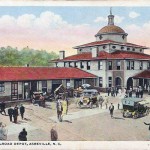- Small-town charm reborn: More than a hundred years ago, residents and tourists arrived by train on Depot Street; more recent years were marked by vacant buildings; but now the street (and the entire River Arts District) are home to shops, galleries and affordable housing. top photo by Marc Lamkin; snowy Depot Street by Jonathan Welch
- Photo by Marc Lamkin
- photo by Jonathan Welch
- image courtesy of the N.C. State Archives
Well there’s two, there’s two trains runnin’
but they ain’t never, no, goin’ my way;
now the one runs at midnight, and the other one
runs just ’fore day.
— Muddy Waters, “Still a Fool”
When the last passenger train pulled into the Southern Railway station on Depot Street more than 60 years ago, the people stepping down encountered a vastly different scene from the one that greets visitors to today’s River Arts District. Across the street from the sprawling, gold-domed, stucco station stood the Glen Rock Hotel which, after passenger service to Asheville ended in the 1940s, catered primarily to railroad workers in between trains.
The original Glen Rock, a grand wooden Queen Anne-style structure, could accommodate up to 125 guests arriving on the daily trains from Knoxville, Spartanburg, Salisbury and Murphy. Demolished in 1930 as a fire hazard, it was rebuilt as part of a thriving business district serving the surrounding African-American residential neighborhoods. Through the mid-’30s, disembarking passengers could also hop a trolley up Livingston Street to Biltmore Avenue and on into downtown.
But by the 1960s, the whole area was in decline. Federal “urban renewal” programs demolished homes and other structures in the adjacent Southside and East Riverside neighborhoods — devastating the community’s sense of cohesion and inflicting wounds that still fester today. Many residents were relocated to public housing projects, and the Glen Rock was sold to a food manufacturing and canning business in 1969. By the time the old passenger station was torn down in the early ’70s, the area was blighted and notorious for criminal activity.
Undaunted, James Green and his wife, Frances, opened a convenience store on Depot Street in 1983 — the first nonindustrial business in the area since before urban renewal. Over the years, Green's Mini-Mart evolved from embattled outpost to community fixture. Meanwhile, the gradual emergence of the River Arts District began bringing new people and new visions to the riverfront.
Big change came to Depot Street after Mountain Housing Opportunities bought the Glen Rock Hotel and adjacent properties in 2006, helping trigger a continuing flood of new development. The Asheville-based nonprofit has a long history of creating affordable housing.
But while many applaud the Depot Street resurgence, Green believes the African-American community is being excluded once again. Mountain Housing Opportunities, he charges, has “all this grant money, but all they do for the blacks is name streets after them and hang pictures up of them. They don't do nothing financially for them: When they finish up, ain't no blacks there with nothing.”
MHO Community Investments Manager Cindy Weeks disagrees. “There has been some talk in the community that the Glen Rock Depot will gentrify the neighborhood. Actually, the economic effect will be quite the opposite,” she asserts. The project is bringing residents to a formerly unpopulated commercial area, she points out. And the work-force housing the nonprofit is providing will actually help ensure that the neighborhood remains affordable for lower-income residents, Weeks maintains, saying, “The complex will never turn over to higher-income families the way that condos do as market prices rise.”
A store for the community
Green grew up just up the hill in an apartment on Clingman Avenue, where the Clingman Lofts complex (developed by Mountain Housing Opportunities, whose office is also in the complex) now stands. After earning a degree as a stationary engineer in the Army, Green settled in Cleveland, working for the city and the board of education. On a visit back home, though, he recognized a need in his former community.
“All my friends were saying, ‘Run me to the store,’ and I said, ‘Well, why ain't there a store in the community for the people?’” Green recalls. Inspired, he cleaned out his retirement account to buy a plot of land on Depot Street. A loan from Clyde Savings Bank enabled him to open Green's Mini-Mart at 414 Depot St. The property now includes an Exxon station and a laundromat as well as the convenience store.
Those first years were rough, he recalls. “When I moved here, I had to sleep in my store on a cot with a gun, because it was totally abandoned, with bums and drifters and robbers.”
But over time, the business became an integral part of the Southside community. Much as other small African-American grocery stores had done before urban renewal, Green’s Mini-Mart carried basic household necessities and served as a communal gathering place. The couple also provided much-needed jobs to residents who had trouble finding other work.
Today, however, the Southside neighborhood — hemmed in by Mission Hospital, A-B Tech and the River District — is finding itself increasingly squeezed. At a Nov. 30, 2010, community meeting held by the Asheville City Council, many residents voiced concerns about a proposed road expansion by A-B Tech that would run through Walton Park and displace a community pool. Residents said they often bear the brunt of intrusive development by big institutions. “Why does it seem that new projects always seem to just help the rich or the River Arts District?” one resident asked (see “A Rough Night at the Reid Center,” Dec. 8, 2010, Xpress).
“Our city’s local African-American community once provided a hefty revenue stream from property taxes, businesses and jobs — until urban renewal came and destroyed these communities,” Robert Hardy, president of the Southside Community Association, told Council members, according to an account of the meeting in The Urban News.
New life
In 2007, Mountain Housing Opportunities renovated the adjacent structure at 362 Depot, now home to The Fine Arts League of the Carolinas. On the heels of that, the organization launched a more ambitious project in 2009: a new four-story, 90,000-square-foot, multi-use structure at 372 Depot St. One of three buildings in the three-acre Glen Rock Depot development, it opened in November, offering 60 one-, two- and three-bedroom apartments on its upper floors and 9,000 square feet of commercial space at street level.
According to Weeks, the average annual household income of 372 Depot's residents is around $16,500. Weeks also says those residents are a diverse lot, though her organization doesn’t make demographic information public. This year, the nonprofit plans to turn its attention to the old hotel, converting it to a mix of retail, office space and artists’ studios.
Randy Shull, co-owner of the newly renovated Pink Dog Creative building at 342 Depot, says these developments are “breathing life into an edge of the river that didn't have a lot of vitality. People feel that artists just make objects or paintings or sculptures, but in this case we're actually creating a community.” In addition to its 16 artists’ studios, Pink Dog Creative is the Asheville Area Arts Council’s new home (see “The Art of Starting Over” elsewhere in this issue). A new restaurant, The Junction, is also expected to open there early this year.
Another newcomer, Chall Gray, agrees. “There really wasn't hardly anything here a couple of years ago when I first started looking at it,” says Gray, who owns The Magnetic Field, 372 Depot’s anchor business. Many of the folks who've attended shows at his combination café/performance venue, he notes, have been pleasantly surprised to find a bustling neighborhood.
Woodrow Eaton lives at 372 Depot with his wife and son. The 27-year-old Eaton, who works at Blue Ridge Biofuels in the River District, says eliminating his commute from the family's former home in Barnardsville has significantly enhanced their quality of life.
“Being able to walk to work and walk home and see my wife and son at lunch … it's definitely what we needed to do,” he reports. Eaton also praises the development’s diversity, noting how many families with children use the courtyard playground.
“I've met several different families of different ethnicities — black, Latino and white — at the playground,” he points out, adding, “There's people from all different walks of life. People that I wouldn't expect to be living in an [MHO] building.”
Growing pains
Green, meanwhile, emphasizes that it's not the people moving into the area that he has a problem with: It’s the organization behind the development. “I'm a people person,” he explains. “People move around, and I'm not territorial like that. People should love each other and work with each other so it makes it better for everybody, not just two or three people.”
But the longtime community member says he now feels alienated from his surroundings. And while others are prospering, Green says he’s facing financial difficulties.
“I feel like I'm poison or something,” he reveals. “I have ideas, but nobody comes to me to say, ‘Can we do something here with you and help you financially?’”
Scott Dedman, Mountain Housing Opportunities executive director, paints a rather different picture. “In 2007-’08, we arranged to partner financially with Mr. Green on condos we plan to build at the corner of Gaston and Congress streets, about five blocks from his store.” The down economy has stalled that project, but “We hope that Mr. Green will want to continue that partnership when housing and financial markets improve.”
In addition, says Dedman, “MHO leased a small lot from Mr. Green for $12,000 during one year of construction at Glen Rock and brought him new customers by hiring over 400 construction workers to work next door to his store — and then bringing 60 new families to live there.”
Still, if things don't improve, Green says he may have to sell his property, though he’d like to pass the business on to his sons. “Everything comes to an end, and I'm just hoping this ain't the end for me. But I feel proud of what I've accomplished.”
Mildred Carson, whose family lived behind the Glen Rock Hotel on Ralph Street when she was an infant, returned to the neighborhood with her husband in 1983, the year Green’s Mini-Mart opened. A longtime volunteer at the W.C. Reid Center on Livingston Street, Carson says she’d like to see the newcomers get more involved in the broader community. But she’s quick to praise the recent development and the increased diversity.
“When I moved back, this area was completely African-American. Now we’re seeing more whites move back in, and we’re seeing things we’ve never seen before.
“There’s some resentment from many years ago … but we have to move on.”
— Freelance writer Christopher George lives in Spartanburg, S.C., where he reports local government news on his blog, FlyingOskar.com.







When I first moved here, I drove around to aclimatize myself to the roads. I did not turn right to cross the tracks at the intersection of Depot and the River Road and found that once east of the intersection, there seemed to be no way out of the neighborhood, a cul-de-sac of cul-de-sacs hemmed in by the railroad and the hills, lots of government housing “projects” and a mostly African-American population. It almost seemed like someone had purposefully barricaded them in using terrain and infrastructure. It made me think of other similar neighborhoods throughout the South which gave birth to the phrase “the wrong side of the tracks”. Maybe this is some of the source of the resentment toward the River Arts District?
BigAl – If you’ve never noticed the rest of the old housing projects, they are all pretty much built on an “island” like that.
1. Lee Walker Heights – built at the top of a hill between Short Coxe, McDowell, and Biltmore. One road in/out.
2. Hillcrest – Bordered by a steep hill above Riverside, 240 and 26. One road in/out.
3. Pisgah View – not quite as isolated but still hemmed in by 240, and the river.
4. Bingham Heights – in no man’s land, hemmed in by the river and industrial property. One way in/out.
5. Deaverview – probably the most accessible/visible…the only one that I can think of that’s not isolated somehow.
6. Walton/Livingston/Depot – you are correct…the terrain between these and ABTech is a natural barrier and then you have the train tracks as another.
I always found it curious that the projects in Asheville were built in these locations.
Why no photo of James Green or his business to accompany this article?